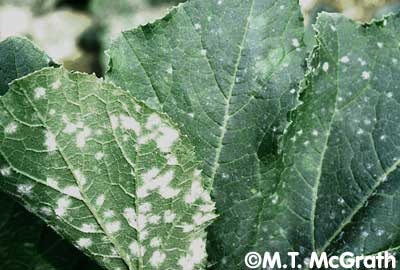Powdery Mildew of Cucurbits
Powdery mildew is a common and serious disease of cucurbit crops in Connecticut. This disease occurs in squashes, melons, gourds, cucumbers, and pumpkins. A powdery mildew infection acts as a sink for plant photosynthates causing reductions in plant growth, premature foliage loss, and consequently a reduction in yield.
Symptoms
Symptoms of a powdery mildew are often easier to identify than symptoms of other diseases because powdery mildew forms obvious patches of whitish mycelium (resembling talc) on upper and lower leaf surfaces, petioles, and stems. First noted on the older leaves, powdery mildew appears as pale yellow spots on stems, petioles, and leaves. These spots enlarge as the white, fluffy mycelium grows over plant surfaces and produces spores, which give the lesions a powdery appearance. Affected leaves become dull, chlorotic, and may show some degree of wilting in the afternoon heat; eventually they become brown and papery.

Photo courtesy of M.T. McGrath, Cornell University, Riverhead, LI, NY
Environmental Factors
The powdery mildews are a group of pathogens that can cause disease over a wide range of environmental conditions. However, several environmental factors may directly affect the development of this disease in cucurbits: temperature, relative humidity and light. Temperatures between 75-85°F and high levels of relative humidity (80-95%) in the absence of rainfall promote the development of this disease. It can become a severe disease when rainfall is low and conditions are dry. Powdery mildew is usually more prevalent in shade than in full direct sunlight; therefore, this disease in cucumbers and muskmelons is more profuse under the large overlapping leaves than the new sun-exposed leaves.
Control
A programmed scouting for symptoms in cucurbit plants is always necessary to detect the beginning of a powdery mildew infection so that a pertinent treatment can be initiated. Strategies for the control of these three different fungal species are very similar and an integrated approach using a combination of several practices will be most effective in managing this disease. Healthy and vigorous plants grown under a good nutritional program and suitable sanitary conditions are less susceptible to powdery mildew infection than plants under nutritional stress.
Plant in sunny areas as much as possible, provide good air circulation, and avoid applying excess fertilizer. In cases dealing with susceptible cucurbits, fungicides may be used. A protectant fungicide prevents new infections from occurring whereas an eradicant can kill an existing infection. Apply protectant fungicides (such as horticultural oils) to highly susceptible plants before the disease appears and use sulfur or biological fungicide eradicants at the earliest signs of the disease.
Plant resistant varieties if possible:
Cucumbers:
Slicing: Ashley, Burpless, Dasher II, Marketmore 76 & 80, Monarch, Salad Bush, Supersett, Trailblazer
Pickling: Calypso, Regal, Score
Winter Squash-Acorn:
Autumn Delight, Royal Ace, Sweet Reba, Table Star, Table Treat, Taybelle, Tip Top
Winter Squash-Butternut:
Betternut, Bugle, Indian Brave, Metro
Yellow Squash:
Fancycrook, Multipik, Patriot II, Prelude II, Success, Sunglo, Sunray, Supersett
Zucchini:
Ambassador, Hurakan, Judgement III, Justice II, Lynx, Payroll, Sebring, Senator, Wildcat, Zucchini Elite
Despite good cultural practices, pests and diseases at times may appear. Chemical control should be used only after all other methods have failed.
For pesticide information or other questions please call toll free: 877-486-6271.
Revised by UConn Home and Garden Education Center 2016.
Issued in furtherance of Cooperative Extension work, Acts of May 8 and June 30, 1914, in cooperation with the U.S. Department of Agriculture, the Dean of the College, Cooperative Extension System, University of Connecticut, Storrs. The Connecticut Cooperative Extension System is an equal opportunity employer and program provider. To file a complaint of discrimination, write USDA, Director, Office of Civil Rights, Room 326-W, Whitten Building, Stop Code 9410, 1400 Independence Avenue, SW, Washington, DC 20250-9410 or call (202) 720-5964.